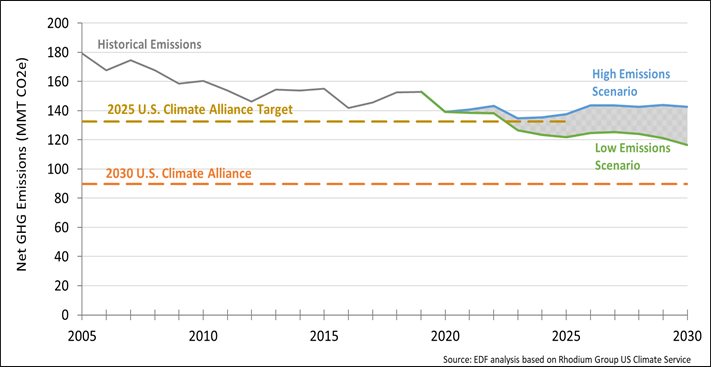Last month, the U.S. Supreme Court ruled in favor of the coal industry and its allies to curtail the U.S. Environmental Protection Agency’s ability to tackle climate pollution from existing fossil fuel power plants. This setback makes action in Michigan and in states across the country – where governors and regulators have powerful tools to deliver meaningful climate action – more important than ever.
Fortunately, Michigan already has a head-start on several other states because in April, the state released the final version of the MI Healthy Climate Plan, an important next step in turning Governor Whitmer’s climate commitments into action. As the governor highlighted in the plan release, communities across Michigan have already been hit by a range of climate change impacts, “from a polar vortex and historic floods to dam breaks and week-long power outages,” and those threats will worsen without strong action.
Where does Michigan stand on climate progress now that it’s published this new Plan? Here are the major advances in the Plan, as well as areas where critical additional work is needed.
Three key advances in Michigan’s climate plan
First, the Plan clearly articulates the ambition and opportunities associated with transitioning to a clean energy, zero-emission economy – an essential step toward implementing policies necessary to achieve that vision. Second, the Plan makes notable advances in centering environmental justice in all the state’s planning and actions to address climate change, including the commitment to meaningfully engaging with communities on the frontline of environmental injustice, climate impacts and the economic transition to a clean energy economy. Third, it rightly frames ambitious climate action as a major economic driver and job creator. Michigan literally builds the electric trucks and cars that the country and the world need to tackle the climate crisis, and by doing so can lead the world in creating the jobs that will drive our future economic growth and rebuild the American middle class.
While these are all key pieces of Michigan’s transition to a zero-emissions economy, next steps following release of the Plan should include a concrete policy agenda that targets the main culprit driving climate change — climate pollution — ensuring it falls at the pace and scale required to put the state on a safer pathway and fulfill the governor’s climate commitments. Thankfully, Michigan has the tools and the opportunity to get this right – and to learn from other states that are successfully turning pledges into policy that delivers.
Michigan’s emissions gap: current state of play
The MI Healthy Climate Plan reaffirms commitments previously made by Governor Whitmer, via Executive Directive and participation in the U.S. Climate Alliance, to reduce the state’s emissions: 28% by 2025 and 52% by 2030, both relative to 2005 levels. These science-based goals are also consistent with the Biden administration’s climate commitments and its Nationally Determined Contribution (NDC) under the Paris Climate Agreement, which set a target of reducing U.S. greenhouse gas emissions 50-52% relative to a 2005 baseline by 2030.
Figure 1: Michigan BAU Net Greenhouse Gas Emissions and Targets, 2005-2030

High and low emissions scenarios based on Rhodium Group’s analysis of factors including fuel prices, technology costs, and economic trends.
EDF analysis of Michigan’s emissions trajectory using data from Rhodium Group’s US Climate Service shows that the state may not reach its 2025 target and is off course for its 2030 target (Figure 1) without additional policy action. Specifically, the state is expected to reduce emissions by 20%-35% below 2005 levels by 2030, meaning on its current path the state will reduce only about half of those needed to achieve its 52% reduction commitment by the end of the decade. Absent more ambitious policy action, Michigan faces an emissions gap – the difference between reduction commitments and projected emissions under current trends – of between 27MMT CO2e and 53MMT CO2e in 2030, showing that significant policy solutions will be necessary to meet the state’s fast-approaching 2030 target.
The policies in the Healthy Climate Plan do not guarantee targets will be met
The Healthy Climate Plan proposes several tools to reduce emissions, including a renewable portfolio standard requiring 50% of the state’s electricity come from renewable sources like wind, solar and hydro by 2030; vehicle electrification goals, EV infrastructure buildout, and sales targets; energy efficiency goals and increased recycling; and land and water conservation. These policy goals, or some variation on them, are all likely to be important pieces of a pathway to reduce the state’s emissions. However, none of the proposed policy solutions or sector-specific goals – other than a goal to reduce emissions from heating buildings by 17% by 2030 – target the metric that truly matters for climate: reductions in climate pollution.
To detail an actionable set of steps that can ensure the state meets its goals, agency leadership in the state should start by quantifying future emissions projections and expected reductions associated with each proposed action. To chart an actionable pathway toward Michigan’s clean economy, the state should then take that analysis of how much each key action is expected to contribute toward its emission reduction commitments, and then identify a suite of enforceable policies to implement that will lead to measurable and certain emission reductions to close the emissions gap between current projections and commitments. While much more analysis of the state’s proposed policy solutions and how they fit into a comprehensive plan to achieve the state’s reduction targets is necessary, here is a quick look at several of the major policies proposed:
- Renewable Energy Standard – electricity generation remains the state’s largest contributor to climate pollution, and to tackle emissions from this sector the state proposes a 50% RES by 2030, in service of 60% of the state’s electricity coming from renewable sources by 2030. Rapidly cutting emissions from the electric power sector is essential to meeting 2030 reduction targets, in Michigan and across the U.S., and so a policy like the one proposed is critical to help meet those targets. In fact, analysis after analysis shows that the power sector needs to secure at least an 80% reduction in carbon pollution below 2005 levels by the end of the decade for the U.S. to have a fighting chance to hit its economy-wide goals. This is why other states, like Colorado and Oregon, have recently established clean energy policy approaches that focus on limiting pollution in the electric power sector. Policies that focus on specific technology deployment– such as renewable portfolio standards, which require a percentage of electricity to come from renewable resources but do not cap total emissions from the sector – can be a valuable part of the solution set, helping deploy the types of clean technologies that will power our future. However, an RPS cannot guarantee emissions outcomes and must be paired with a policy that ensures pollution declines at the pace and scale necessary.
- Electric Vehicle charging and purchase incentives – transportation is the second largest source of emissions in the state, and the state proposes to tackle these emissions through a combination of purchase incentives that make EVs less expensive and buildout of EV charging infrastructure to support 2 million EVs on the road by 2030. These actions can help accelerate EV uptake, and their implementation is likely to be a valuable part of decarbonizing transportation. Without an analysis of how these policies will impact transportation emissions and how that fits a comprehensive plan to reduce economy-wide emissions by 52%, however, the scale of the transition outlined may not be sufficient to achieve the state’s goals. Because average turnover for passenger vehicles is over a decade, ensuring swift transitions to EVs is critical to meeting near-term climate goals. With automakers like GM committed to sell only zero-emission vehicles by 2035, the birthplace of the auto industry has the chance to lead the transition to zero-emission transportation and in doing so reduce climate pollution, create jobs, save families money and improve public health.
- Decarbonizing buildings – unlike other proposed solutions, the Plan includes a sector-specific emission reduction target for building heat: a 17% reduction in GHGs by 2030. This kind of emissions-focused target is a critical step in determining the right mix of policies. While the plan includes several policies to decarbonize buildings, many of which are likely to be important for meeting the overall goal set in the Plan, there is limited specificity regarding how these policies add up to the reduction target identified. Examples of state policies focused on sector-specific emissions limits that Michigan could look to as guidance include Oregon’s binding limit on emissions from fuel suppliers, which would cap emissions at 50% of 2005 levels by 2035 and 90% by 2050 from transportation fuels and natural gas; and Massachusetts’ work to develop a policy menu—including designing a pollution limit—to achieve a specific sectoral targets from transportation, gas distribution and other sectors.
Taking the next steps toward solid policies that deliver
At its core, climate change is a pollution problem, and policy approaches should treat it like one. The Michigan Department of Environment, Great Lakes, and Energy (EGLE) has robust authority to regulate air pollution under the Natural Resources and Environmental Protection Act. Since that statute was adopted nearly thirty years ago, EGLE has adopted numerous rules to regulate air pollution in the state.
Michigan does not have to look far to see how this can be done: States like Pennsylvania and Oregon have just concluded regulatory efforts, using existing authority to control air pollution, to put direct limits on different sources of greenhouse gas pollution including via caps on emissions from electric generators in the power sector, fuel suppliers in the transportation sector, and fuels such as natural gas in the buildings sector. Moreover, over a dozen U.S. states have adopted regulations that put in place firm and enforceable limits on greenhouse gas pollution that can ensure commitments are met – an essential component to climate leadership. These programs would work hand-in-hand with the policies focused on transitioning to zero-emission technologies outlined in the Plan.
So where does Michigan go from here? Michigan’s leaders should immediately take these three next steps to meet the climate challenge, secure new good-paying, clean energy job opportunities and cut harmful air pollution:
- Identify and thoroughly understand the state’s current emissions trajectory and the “gap” between projected emissions and its emissions targets. This should start with the state’s own comprehensive emissions inventory, from which it can assess future emissions projections and where they are compared to its reduction targets.
- Once this gap is clearly understood, EGLE should measure and align its policies with its targets, by quantifying the potential pollution reductions of state policies to understand which drive the deepest reductions with the greatest level of certainty. Regulators should also total the potential reductions from each policy and add them together in a comprehensive, economy-wide plan that’s capable of closing the state’s emissions gap.
- Swiftly put meaningful policies in place, leveraging an expansive toolbox – especially with tools EGLE already has – to maximize emission reductions in the near-term and ensure the state is able to limit overall climate pollution.










